




The previous page photo was taken at Fort Yukon, Alaska.
Interview of Lt. Col. Mike Coffing by Laura Emerson
Most CAP members join because of a friend’s introduction, or an interest in aviation.
Lt Col Mike Coffing joined because of a tragedy. Back in 1996, he was working with the Department of Fish and Game in Bethel. In late November a colleague conducting a moose survey was aboard a chartered 185 that crashed. Both the pilot and surveyor died. It was CAP that found the location of the crash.
Bethel had a very active squadron at the time, and after a few years he became the acting commander and then commander. Their headquarters was a hangar that CAP shared with the Troopers. Many of their searches using aircraft were in CAP N9484X and a Beaver with wheel skis. Several Bethel CAP members also owned their own personal planes and those aircraft were frequently used for searches as well. Most of the searches were for overdue snowmachiners, missing boaters/hunters and of course missing aircraft and active ELTs.
Spring breakup is the single largest flood threat to rural communities along the major interior rivers, especially the Yukon, Kuskokwim and associated tributaries. Floods are not uncommon during Spring break-up, but some years are much worse than others.
Coffing recalls one year Yukon River breakup flooded Russian Mission and moved the mostly empty fuel tank off its gravel pad.
When living on Bethel’s Seventh Avenue with Brown Slough just across the gravel street, Coffing ha dtied his boat up to the door step and had floodwaters one foot from going inside his house. It can get personal real quick!
For several years the Alaska-Pacific River Forecast Center (APRFC) has tasked CAP with gathering photographs useful in prediction flooding on the Kenai River due to summer releases of glacial dammed lakes. In 2017 the APRFC needed a quick response to get eyes on information and photos of flooding near Tetlin. The Tok squadron was tasked with flying the area when the road to Tetlin was flooded in late summer.
Starting in 2020, the APRF requested CAP to conduct sorties to photograph ice conditions on the Yukon and Kuskokwim rivers and associated tributaries. The goal of the RiverWatch program is
to assess river ice conditions and evaluate flood potential in order to warn communities. The aim was for CAP pilots/crew members to capture geotagged images of the river ice, allowing hydrologists in Anchorage to combine these photos with satellite imagery and community observations to stitch together an accurate picture of the evolving situation.
There are 17 communities along the Kuskokwim River and 11 communities along the lower Yukon River in these areas where the APRFC usually requests CAP to fly and take photos. Meanwhile, similar photo surveys of the upper Yukon River, between the US – Canada border and Circle, are also flown by CAP as well as the Tanana River area between Big Delta and Manley Hot Springs. The APRFC has very limited funding that it can use for CAP flying and most of the sorties needed are in remote rural areas with little on-site CAP presence.
Lt. Col Coffing helped plan and coordinate these sorties between APRFC and CAP. In 2017, Fairbanks flew 9 sorties all related to the flooding near Tetlin.
Since 2020, APRFC requested 15 different sorties, of which CAP flew 11. In recent years, Bethel flew four sorties, Tok three and Fairbanks four.
Celine Van Breukelen of NOAA says, “The National Weather Service’s Alaska-Pacific River Forecast Center wholly appreciates the partnership and support of the Alaska Civil Air Patrol. We have worked together for years to monitor Glacial Dam Lake outbursts, river erosion and pre breakup reconnaissance. During the springtime breakup flood season, the NWS works with the State Emergency Management Center, and local communities along the river in a program called “Riverwatch”. During this program a hydrologist, emergency manager and local observers fly the river to predict breakup flooding. We view the CAP flights as the first wave of Riverwatch -by sharing the pictures captured during the CAP flight, it allows us to give communities a first look at ice conditions to aid them in their local flood preparedness.
This spring, CAP was instrumental in flying three missions prior to river breakup. The Tanana mission allowed us to advise the State Troopers on how much longer the ice would be safe during their accident investigation. The Upper Yukon and Kuskokwim missions were prior to the launch of the Riverwatch Teams and gave us a better understanding of where these rivers were in the breakup progression. CAP allowed us to provide earlier service to the communities, and save taxpayer dollars by helping us estimate the breakup timing and when a hydrologist needed to be in the community for flood prediction.”
Two years ago, 2nd Lt. Pete Pritchard joined the Arcturus Squadron at JBER Air Force Base in Anchorage.
He brings to CAP extensive experience as an Emergency Incident Commander, including Type 1 Emergencies that require more than 500 responders. As I write this, he is in Baltimore, supervising the dismantling of the Francis Scott Key bridge at the beleaguered port (photo in background taken by Lt. Pritchard).
For the last dozen years, Pritchard was hired by major corporations around the world to oversee the response to emergency incidents such as oil spills, chemical leaks, and resulting industrial fires, and train derailments. He has also supervised restoration efforts after natural disasters, like floods, tornadoes and hurricanes.
Thirty years ago, though, he started his career in maritime incidents in the US Coast Guard National Strike Force, and has returned to that specialty. In support of the Incident Commander, Pritchard’s role is to establish the response priorities and objectives so that various teams, such as firefighters, police, communicators, health providers, and politicians or corporate leaders can execute their plans.
In CAP, Pritchard’s focus is Communications. He has several HF radios and antenna systems at his home and participates in national, regional, and state-wide radio nets.
Pritchard has also enjoyed serving as President of the JBER Radio Club and Alaska Group Commander of Air Force MARS (Military Amateur Radio System). Why communications? “Managing personnel in an emergency is all about communications, both interpersonal and technical,” explains Pritchard. On the personal side, we have two ears

and one mouth. Good leaders listen more than they talk. We have to listen to the observations, needs, and concerns of others, decide on a course of action, and then convey it clearly to team leaders so they can develop and execute Plans A, B, and C in coordination so as not to compete for resources. This communication is an iterative process throughout the emergency. ”
“On the technical side, the emergencies I deal with occur in settings and situations where the communications grid does not exist or has been severely damaged. And more often than you would think, the various responders, like the police, firefighters, and EMS may have communications systems that are incompatible! (Once, as a paramedic, I was called out for a broken leg, but in reality, the patient was about to give birth!) One of my key jobs is to create an ad hoc communication system among the response teams and to outside stakeholders. Handheld radios work in line of sight situations, but where terrain varies, we often have to string antennas, con-
struct temporary cell phone towers and repeaters with the emergency tow-behind equipment from telephone companies.“
Why did he join CAP? Pritchard muses, “There is a lot of overlap between my career and CAP’s mission, particularly in Alaska, with the state’s challenging terrain, weather, and patchy communications grid. I think I can help with adversity planning.”

“I am also impressed with CAP’s excellent job of teaching the cadets lifelong skills, including interpersonal communications. You can’t teach common sense, but you can mold it. CAP cadets learn to operate in groups, in teams, as leaders, and in support roles. Think of basic radio messaging: I identify the recipient, I identify myself, I pass a succinct message and confirm that the message was received. This call and response skill is appropriate in every interaction, from dog training, to friendships, to teaching, to jobs. “
“I am proud to be affiliated with Civil Air Patrol.”
By Lt. Col. James McIntyreAs a squadron commander, I received a nice surprise when I opened my email recently on an early Monday morning.
A couple of years ago I was introduced to some very bright-eyed teenagers. They had heard about Civil Air Patrol and wanted to know more as they had a goal to become pilots. They asked great questions about the cadet program and decided to join. Then Covid hit. Well, they continued to put in the effort and progress in the cadet program and followed the steps in the Wings program. A couple encampments and glider academies along the way and well, when I opened my emails on April 29 – C/1st Lt Caelyn Wise had graduated from the Wings program. WooHoo! C/1st Lt Christina Wise graduation announcement soon followed. Two new licensed pilots, AWESOME!
Following this news I was able to help out at the Alaska Airmen’s Aviation Gathering the following weekend. Teenagers, parents and other passerby’s would ask about the ability to get a pilots license through CAP and I was able to relay that two of my cadets completed their private pilots license just the prior weekend through a Civil Air Patrol program called Wings, and they graduate high school next week-
end. How is that as a testament to the success and viability of the program? But it gets better. I happened to cross paths with these two on Saturday afternoon at the Aviation Gathering. They were smiling ear to ear, along with their parents; as they had just taken their parents up on a flight; as their pilots!
To highlight one aspect of what these cadets endured to reach this goal is that they drove from Valdez to Anchorage, around 290 miles one way, a six to seven hour drive, week after week to complete their flight training. Sometimes after they arrived in Anchorage, the weather would cancel the ability to fly that weekend. But they kept at it. Following through until they completed the requirements and achieved their goal.
Below are words from these two cadets reflecting on reaching this goal:
My best part of my flight instruction was when I was in the air flying. The hardest part was the radio calls and all the ground knowledge work. And advice for other cadets is to practice, stay focused, create goals, and follow your dreams.
From Christina Wise:
The best part about the training was being able to fly every week, and the hardest part was at first the radio calls,


but then the weather stopping flights. I would advise cadets to study ahead of time, keep practicing, and to write out their goals.
Congratulations Cadets on your success! I look forward to seeing what else you set your sights on and accomplish.
To other cadets reading this - yes, this is possible.
Top photo: C/1st Lt Caelyn Wise
Bottom: C/1st Lt Christina Wise
Don’t look up an interview with C/CMSgt Bennett by C/ Capt Kai Halliburton.
At least 4,000 Civil Air Patrol members turned out April 8 for what’s likely the organization’s largest single-day mission ever — assisting NASA by collecting more than a quarter-million data points from the total solar eclipse.
One squadron that participated in this research gathering mission was the Lake Hood Squadron, lead by C/CMSgt Bennett. The following information was gathered by C/Capt Halliburton in an interview with Chief Bennett to shine some light on how this mission went for her and her team.
At 7:30am on Monday, April 8th, Cadets Bennett, Jensen, Kubosh, Davis, and Simpson arrived at the Alaska Sled Dog and Racing Association clubhouse to begin setting up to gather their data. The goal of this mission was to gather data on how solar eclipses affect weather patterns and VHF radios. Throughout the day teams of two or three cadets went outside to gather information on the weather, such as temperature, cloud cover, precipitation, and wind speed. While
they were doing this, another team cadets made radio transmissions back forth and recorded any noticeable interfer ence.
Along with the data collected for NASA, Cadets had the opportunity to go through some in-person ES training. Each Cadet to go through Introductory Communica tions User Training, and become familiar with the radios they were using to become Mission Radio Operators.
The gathering of data is a crucial part science, and one of the most effective for organizations like NASA to gather mation on a Nation-wide scale is to help from “citizen scientists” where conduct the research and send in their ings to NASA for analysis. This mission an official partnership between CAP NASA. To put it in Chief Bennet’s words, “It’s like a match made in heaven.” With many members eager to help out all the nation, it makes data collections more streamlined.
According to Chief Bennett, overall mission was a success. Unfortunately to the eclipse path, they did not get the total solar eclipse like some wings but they gathered accurate and important information about the eclipse.
of two back and interfer-
NASA, through Cadet had Communicafamiliar become part of effective ways gather inforask for where citizens their findmission was CAP and words, With so all across collections much the Unfortunately due get to see wings did, important

Leadership is the cornerstone of the cadet programs. Polaris Composite Squadron is dedicated to empowering members to lead effectively. From providing opportunities to lead search lines to instruct drill techniques, every activity fosters an environment for cadets to grow as leaders within Civil Air Patrol and beyond.
C/MSgt Wilcox (Left) instructs C/Amb Laidlaw (Right) on how to march (bottom left).
Cadets practice marching movements in formation (top right).
C/CMSgt Burke (Right) inspects C/SrA Thibault’s (Left) uniform (far lower right).
Congratulations to the cadets who were promoted this month, fly high!

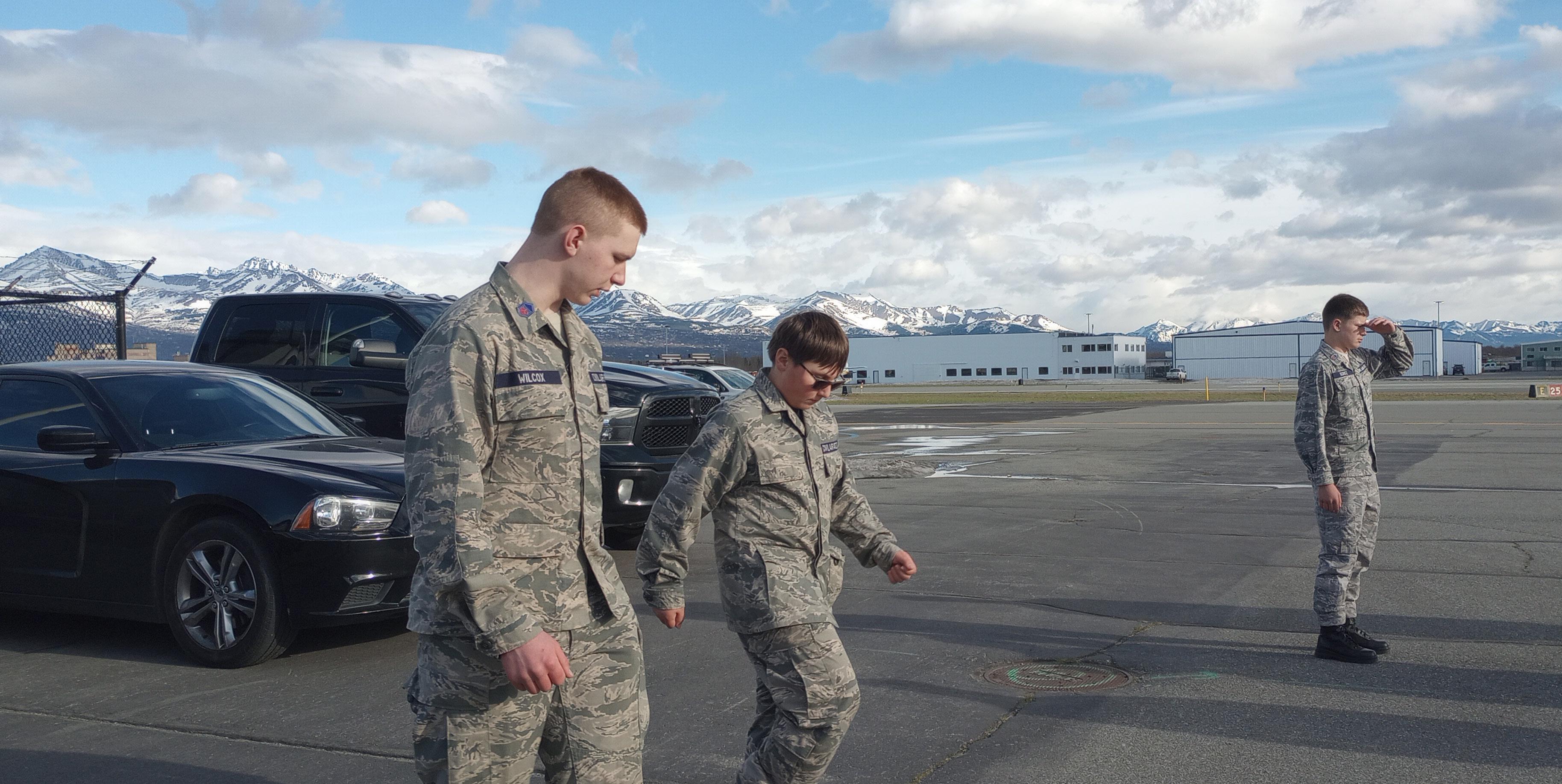
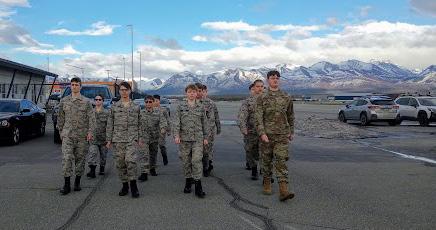



Greetings, Alaska Wing Cadets!
The Alaska Wing Cadet Advisory Council (AKWG CAC) has been busy this first half of FY2024 working to improve your experience in the Wing and, more importantly, the Civil Air Patrol. The CAC has many exciting ideas and opportunities planned for the year. From recent events such as the 2024 Pacific Regional Conference in Portland, Oregon, to the upcoming C-17 Alaska Air National Guard orientation flight on JBER, to AKWG’s 2024 encampment, the CAC works closely with directors of these events to ensure the best possible outcomes for cadets in the Alaska Wing.
The current AKWG CAC staff includes C/Maj Thomas Clifton as the Wing Chair, C/Lt Col Katarina Lukic as the Vice Chair, C/1st Lt Grania Wegemer as the Committee Recorder, C/2d Lt Michael Krol as the Wing’s Primary Regional Representative, and C/ Maj Reagan Benedict as the Wing’s Assistant Regional Representative.
In March 2024, three AKWG CAC committees presented position papers to the Wing Commander, Col Derk MacPherson, recommending many new ideas to improve the program. These included the “See the World” Committee, which was geared towards increasing attendance, awareness, and access to wing, regional, and national events. The Recruitment & Retention Committee focused on studying cadets’ interests and hobbies to increase interest among the public for CAP, as well as finding ways to keep cadets interested. Lastly, the CAC Changeover Committee to develop a method for the CAC to streamline our staff changeover ap-
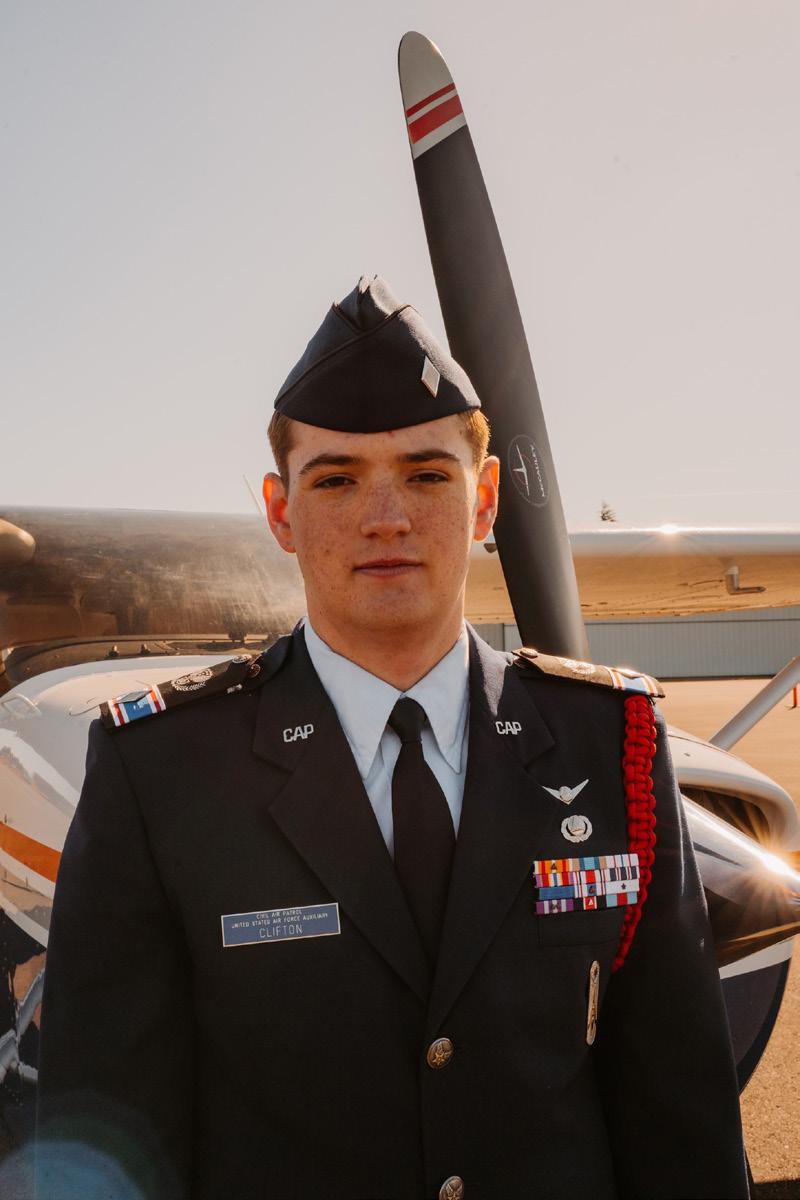

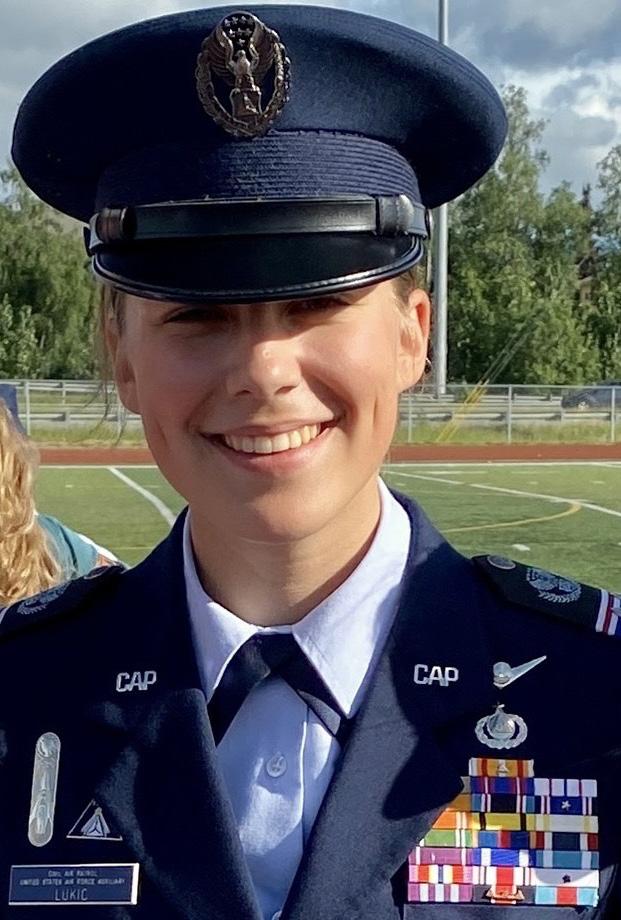

proach. The CAC received positive feedback from Col MacPherson who ordered the council to carry out many of the ideas starting immediately and continuing throughout the term.
The “See the World” Committee transitioned into an “Action Committee” to carry out Col MacPherson’s orders. The “Action Committee” ‘s priority focus is making wing, regional, and national activities more accessible to AKWG cadets. Some ideas to accomplish this are proposed outreach opportunities and virtual instruction seminars to be conducted by cadet executive leadership.
CAC committees consist of cadet members who volunteer to join at least one committee when they sign up for the CAC. Committees focus on solving certain problems and/or brainstorming new ideas to initiate positive change within the wing. The wing commander chooses the subject of each committee and the desired results. The Alaska Wing CAC usually has 2 to 3 committees collaborating at any time.
A new committee created for the second half of this CAC term is the “Communications Committee,” chaired by C/Maj Reagan Benedict and vicechaired by C/2nd Lt Gunner Lotz. The “Communications Committee” was established to resolve issues with communication between the cadets, senior members, and commanders of AKWG. The committee met for the first-time last month, drafting a survey to assess the current status of communications within the wing. The committee is asking all AKWG cadets to participate in this survey, which is available here: Alaska Wing Communication Survey (surveymonkey.com)
CACAnother new CAC committee is the “Emergency Services Committee,” chaired by C/CMSgt Adam McArthur and vice-chaired by C/2nd Lt Gunner
Lotz. This committee will focus on creating and developing emergency service-based opportunities for cadets and senior members of the AKWG and will work hand-in-hand with developing the AKWG quarterly SAREX and other ES activities wing-wide.
Other exciting CAC news within the region is the Pacific Region held its annual regional conference in Portland, Oregon, on April 19-20, 2024. Many Regional CAC members, including myself and C/2d Lt Krol, gathered and conducted our first in-person conference of the year. High-ranking officials such as the current national commander, Major General Edward Phelka, and many current and former Pacific Region commanders and wing commanders, including AKWG Commander Derk MacPherson, attended the event.
regional council enjoyed a banquet dinner and a luxury 4-star hotel stay for the weekend. This event highlights why you, an AKWG cadet, should consider joining the CAC. You can contribute to making your wing a better place to serve and, at the same time, be exposed to fun opportunities such as the regional conference.
During the conference, the Regional CAC members discussed various committees such as the Off-season/CSA Committee, which covers topics like Cadet Special Activities and wing/region events, the CAC Revision Committee, which determines how to improve and innovate the council, and the newly-established “Squadronism” Committee, which evaluates squadron-specific policies and rules that differ from national regulation, which determines whether this approach has a positive or negative effect on the squadron or group’s growth. The cadets on the
If you want to hear more about the AKWG’s CAC operations, contact your local squadron representative, cadet commander, Deputy Commander for Cadets, and/or Squadron Commander. Additionally, the CAC will include a monthly article in the wing newsletter to keep members informed. If you have any questions regarding the council or anything mentioned in this article, please contact me at 659204@ akwg.cap.gov.
Take the survey now: https://www.surveymonkey.com/r/NWLX2G5
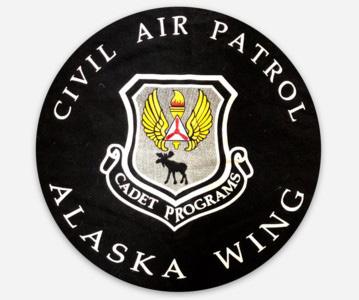
On April 2, 2024, the regulation and pamphlet for the Chaplain Corps, including CDIs (Character Development Instructors) was updated.
CAPR 80-1, The Civil Air Patrol Chaplain Corps Regulation can be found here: https://www.gocivilairpatrol.com/media/cms/R_801_7_ March_2022_16CAD11D61D57.pdf
CAPP 40-80, The Chaplain Corps Handbook and Specialty Track Guide, can be found here: https://www.gocivilairpatrol.com/media/cms/P_4080_2022_ C327F8B9DD0EA.pdf
All unit commanders are now required to have at least one chaplain or CDI assigned to the units (See Paragraph 2.6 of CAPR 80-1, which states “Squadron commanders ensure their unit is staffed with qualified chaplain and/or CDI personnel. Squadron commanders, assisted by their squadron chaplains and CDIs, approve all squadron Chaplain Corps activities and ensure the squadron operates in accordance with this regulation.”)
Note that Chaplains and CDIs can be assigned to multiple units. Alaska
Wing currently have 4 Chaplains and 9 CDIs, many of whom are willing to serve squadrons in addition to their home squadron.
Senior Members can apply to serve as CDIs by completing CAP Form 80-2 (https://www.gocivilairpatrol. com/media/cms/CAPF_802_2022_ BCA1BF2490583.pdf), referring to the regulation and pamphlet to respond thoroughly to all questions on the application.
Chaplains must be ordained, and can apply to serve as Chaplains by completing CAP Form 80-1 (https:// www.gocivilairpatrol.com/media/ cms/F_801_2022_0B8BF7226AF7F. pdf)
For more information regarding Alaska Wing’s Chaplain Corps and CDI Corps, please email Wing Chaplain Maj Kevin Bottjen at kbottjen@hc.cap.gov and Wing CDI Capt Karen Padgett at karen. padgett@akwg.cap.gov. For quickest response, please email both of us at the same time.
Alaska Wing Director of Cadet Programs
Article by 1 st Lt Rick Benedict, Deputy Commander for Cadets
In April the Birchwood Squadron welcomed Lt Col Chad Foreman, an Alaska Air National Guard member and C-17 pilot. Lt Col Foreman shared his experience as an Air Force Academy graduate and former C-17 Air Force pilot. Lt Col Foreman’s presentation was well received by many Birchwood cadets who are strongly considering applying to attend the AF Academy. He provided very valuable information concerning what steps cadets can take now to become strong academy candidates, the benefits of attending the academy, and how graduating from the academy impacts their chances of being slotted as an AF pilot. We are very thankful to him for his many contributions to the cadet program.
Capt Kyle Zimmerman of Birchwood received all his final approvals from Wing, making him an official CAP pilot and CFI. Captain Zimmerman provided a full weekend day of powered ground school instruction to cadets and senior members at the hangar. There was a very strong turnout for the opening of his class, which continued later into the month as a regular one-hour series he will continue when available before regular Tuesday meetings. Cadet Maj Mitchell Anderson has been supplementing ground school classes as the
Cadet Aerospace Education Officer for the squadron. His April class focuses on obtaining and reading METARs and weather patterns.
Capt Sonya Hood took on the Squadron’s Public Affairs position and will be working to improve the squadron website and Facebook pages. Captain Hood can be contacted at sonya.hood@outlook.com with any event notices or public affair items for potential placement on the squadron’s website and/or Facebook page.
Cadet Maj Reagan Benedict attended the Pacific Region’s 2024 Conference in Portland, Oregon, representing the AKWG CAC as the Assistant Regional Representative. During his visit, he met face-to-face with other Regional CAC cadets who are all working hard to ensure every cadet across the region can experience the best of what CAP offers. Cadet Maj Benedict has also made a strong push in April to improve the cadets skills and abilities related to Emergency Services, 24-hour pack preparation, and shelter building for preparation of AKWG’s May 2024 SAREX exercise at the Birchwood Airport.
Birchwood cadet staff members, many of whom were newly appointed for a six-month term, began learning about their new positions and getting familiar with the job duties throughout
the month. Staff are currently working to improve squadron communications within the chain of command, and executive staff are working to update and bring current the squadron’s cadet program Standard Operating Procedures (SOP) handbook. Executive staff would like to welcome the following cadets to their new positions:
- Cadet SSgt James Wood – Bravo Flight Sergeant
- Cadet SMSgt Mya Cole – Alpha Flight Sergeant
- Cadet SrA Evann Haddock – Activities NCO
- Cadet CMSgt Jonathan Shelley – Assistant CAC Representative
- Cadet SSgt Noah Andrews – Recruiting NCO
- Cadet SMSgt Elizabeth Barnette –Leadership Education NCO - Cadet SrA Aurora McAtee – Supply Airman
The Birchwood cadets finished off April with a fun meeting night due to there being five Tuesdays in the month, with lots of potluck-style food, a fun field hike, and badminton and volleyball games.


The Great Alaska Aviation Gathering was held on May 4th & 5th. This is the 4th year in a row that this growing event was held at the Palmer, Alaska Fair Grounds. Each year it gets bigger and better than the year before. The show had run for years in the Fed Ex Hanger at Anchorage International Airport.
The Alaska Wing has sponsored a booth at this event to promote Civil Air Patrol. The Alaska Wing would
like to thank The Alaska Airmen’s Association for their support of CAP as well as the CAP members who staffed the booth. A special thank you to Lt Col Jim McIntyre, Lt Elizabeth Justus, Lt Col David Thompsen, Lt Col John Western and Col Kevin McClure. The Alaska Wing salutes you!
Plan to attend next years Great Alaska Aviation Gathering. It is a 2-day event held during the first full weekend of May. Plan now to assist in some way the Alaska Airmen with The Gathering. Plan now too in helping how you will advance CAP’S Mission of “Supporting America’s communities with emergency response, diverse aviation and ground services, youth development, and promotion of air, space and cyber power”.
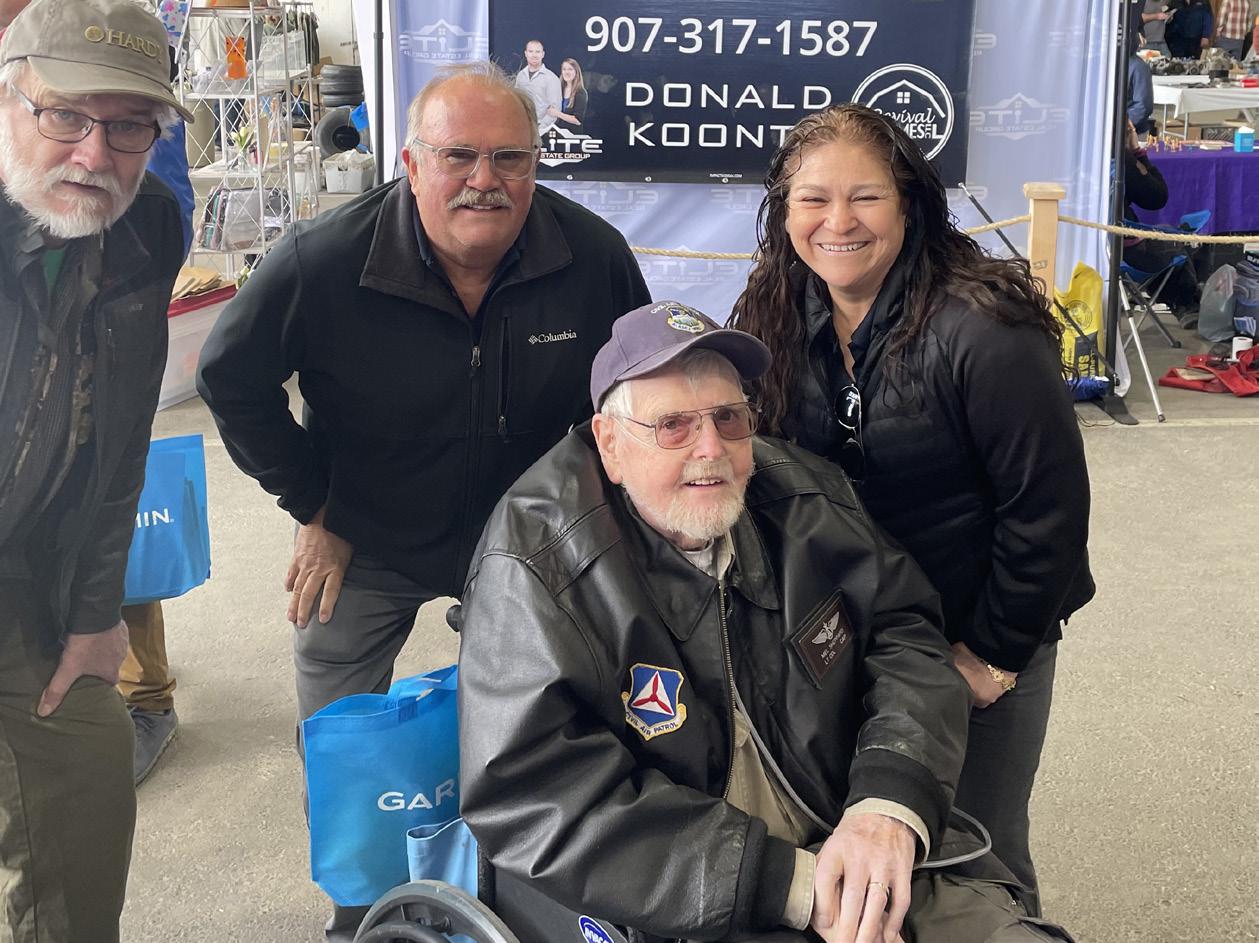

Cadets, This could be you someday!
Congratulations to 3 Alaska cadets who earned their Private Pilot Licenses in the last few weeks through the CAP Cadet Wings Program!!
- C/Maj Thomas Clifton of Southeast (Juneau/Sitka) Squadron on 4/9/24 (photo lower right)
- C/1st Lt Caelyn Wise of Valdez Squadron on 4/25/24 (previous page photo)
- C/1st Lt Christina Wise of Valdez Squadron on 4/27/24 (previous page photo)
Three other AK cadets are in this year’s Cadet Wings program and still working on their licenses.
To best prepare yourself to apply for the upcoming Cadet Wings flight training scholarships, you need these 4 “ingredients,” ideally by July 1, 2024: - Student Pilot Certificate - Class 3 (or better) FAA Medical - Passing score on the FAA written test - Solo (in glider and/or powered aircraft)
Details on how to work towards the above “4 main ingredients” and other requirements are available here: https://akwg.cap.gov/programs/cp/ flighttraining
The Cadet Wings Guide, CAPP 6043, is available here: https://www. gocivilairpatrol.com/media/cms/ P_6043_7B02E937DF565.pdf
Start your application on July 1, 2024. Wing Staff can view your application once you start it. We are standing by to review your application before you hit “submit.” Email cp@akwg.cap.gov to request that someone look it over and suggest any revisions.
(NOTE: The website is being revised. If the above link doesn’t work, from the Alaska Wing website, http://akwg.cap. gov, go to Programs, Cadet Programs, then look for “Flight Traning Pipeline” or equivalent)
Additional information:
Age: This year’s Cadet Wings powered flight funding will be awarded to selected cadets born between September 2004 & September 2008. These dates ensure a cadet is old enough (17) by the end of the funding year, September 2025, to qualify to become a pilot and young enough (under 21) to still be a cadet. If you are too young this year, consider going through the application process anyway so you learn how it works.
FAA Written: NOW is the perfect time to start working through ground school so you can complete it, take
a few practice tests (we recommend Dauntless), get an endorsement, and take the FAA written test. The better you do on your test, the easier your eventual oral exam will go. Consider applying to the 2024 Alaska Wing Encampment Advanced Training School. The primary objective for this year’s ATS will be to help cadets learn what they need to pass the test (aka Ground School) then take the FAA written test before leaving encampment. If registration if full, apply for the wait list! You may get in. And this helps us see who is interested in flight instruction.
Soloing: If you have not been selected for a Powered or Glider flight academy this year and have not already soloed, consider taking lessons from a flight school in your community. Many Cadet Wings recipients soloed independently then received funding from CAP to continue their flight training.
Ray Navigator: A Ray Navigator is a CAP Senior Member who will mentor you through the Cadet Wings program if you are selected. They need not be
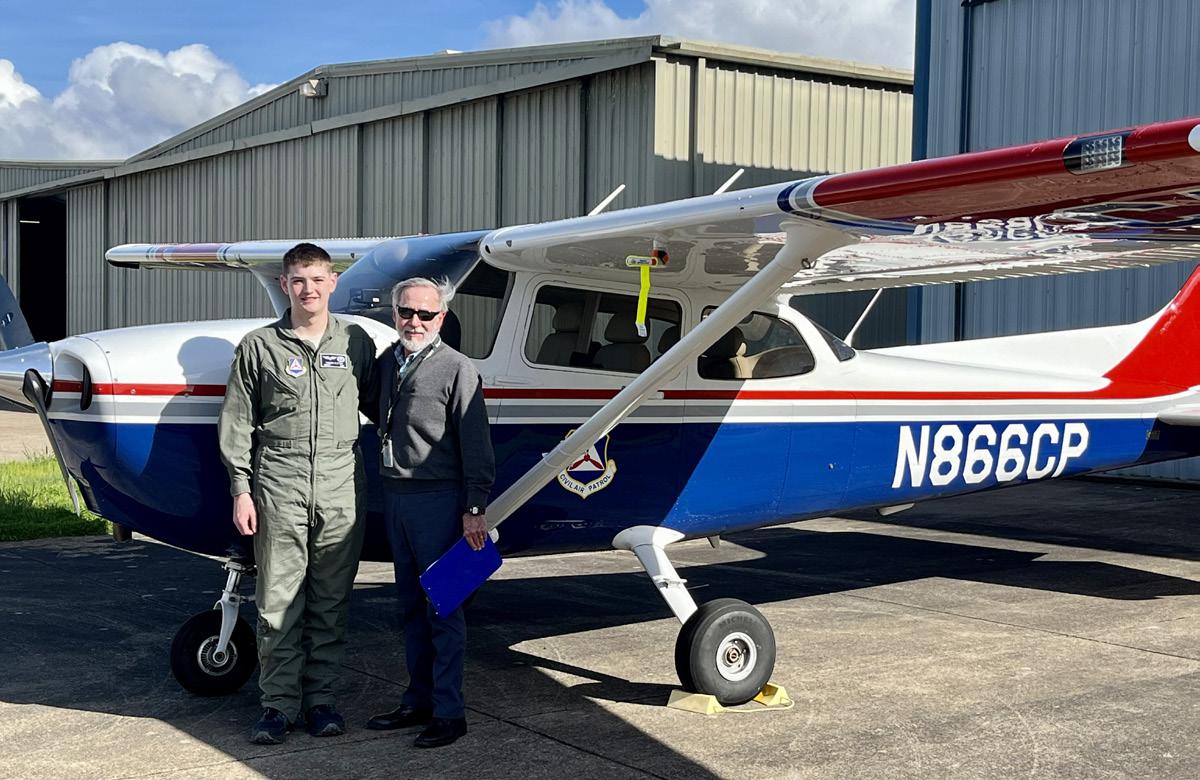
an Instructor Pilot. Having a Ray Navigator qualifies you for additional funding sources and increases the chance you will be chosen for Cadet Wings.
Paths to Choose: If you have all 4 ingredients listed above, we recommend you apply for “Airplance Single Engine Land (ASEL)/powered” instruction through a “Commercial FBO/Flight School.”
If you do not have all the ingredients but would like to apply anyway, we recommend you apply for the in-residence program. Complete the question that asks what date you would be available to spend 4 or 8 weeks learning everything you need to earn a pilot’s license at a university in the Lower 48. A much smaller number of cadets are chosen for this program, so you have a better chance of receiving Cadet Wings funding if you have the “4 ingredients.”
Capt Karen L Padgett Alaska Wing Director ofCadet Programs
On 3 August 2024, Alaska Wing will have its annual communications effectiveness exercise. Don’t yawn yet, because this gets better.
All CAP wings and regions are required by regulation to have an annual communications effectiveness exercise. It’s an inspection item. This year, we’re going to do this exercise differently, and we’re going to try to make it fun.
For our exercise, Alaska Wing will have an HF radio contest. The contest will be called the Aurora Borealis Communications Development Exercise, abbreviated ABCDE.
Civil Air Patrol HF station operators will be invited to compete by contacting the Alaska Wing stations. Points will be awarded to both the Alaska Wing station and the contacting station. The high point station in Alaska and the high point station outside of Alaska will be the contest winners, and will receive prizes.
For a copy of the contest rules, please email LtCol. Kristin Freeman (480550@akwg.cap.gov).

Because prizes will need to be ordered, all stations must register in advance. A station may have only one person, or it can be a team effort (which is what is suggested).
Any CAP member who is ICUT and ES qualified may participate. This exercise may be used to work toward or renew qualifications, including MRO, MSA, Public Affairs, and Safety. All AKWG members who participate in the exercise for at least six hours will receive a challenge coin designed for this exercise. Time spent preparing for the exercise, and taking down equipment and documenting results afterward counts toward the six hours. teams win at are power Registration made cate LtCol. akwg.cap.gov) son Indicating Communications help ommended. Hope
If you or your unit doesn’t have an HF radio, Wing Communications can help you. We have a limited number of RDP’s (like an HF radio station in a small, 40-pound suitcase) that we can loan out (first come, first served). They are easy to set up and operate. They are ideal for units that meet in office buildings or similar venues where a permanent antenna installation is out of the question. We also have some HF radios that need homes, and we’ll make those available, too. We will give you guidance and help in setting up a station at your home or squadron.
The contest rules don’t just level the playing field; they tilt it toward teams that include cadets. The way to win this contest is to have a team of least four people, two of whom are cadets, and use a generator to power the radio!
Registration information will be made available soon. You may indicate interest at any time by emailing LtCol. Kristin Freeman (480550@ akwg.cap.gov) or LtCol. Bryan Emerson (bryan.emerson@akwg.cap.gov). Indicating interest early will give Communications staff more time to help you set up a station, so it’s recommended.
Hope to see you on the air!

Pro Tip: In the last 3 months, 32 Senior Members and 28 cadets have fallen off the Alaska Wing membership roster. When members do not renew their memberships, they disappear from eServices, and it is difficult to contact information for them.
Commanders do not currently receive notice when members expire. On the first of each month, they might just notice that the number of members in their squadron is smaller.
Here is how you can find out who is missing and encourage them to renew. If you are not able to run this report yourself, ask your unit Personnel, Deputy Commander, or Commander to run this report for you.
In eServices, go the Main Menu, then Reports, then Member Reports.
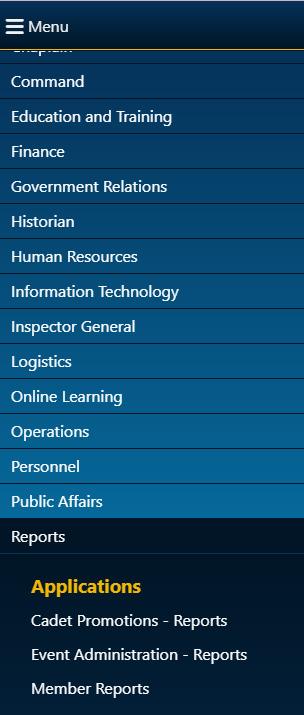
In the Member Reports section, click on the red down arrow for the Member Reports pulldown menu and select “Member Reports” again.

From the Reports pulldown menu, choose the report called “Membership.” Check the “include contact” box, select your unit, then select the radio button for “View Inactive Members Within the Past 90 (or 180) Days.” Choose Cadets, Seniors, or all, then select the format in which you’d like to receive the report.
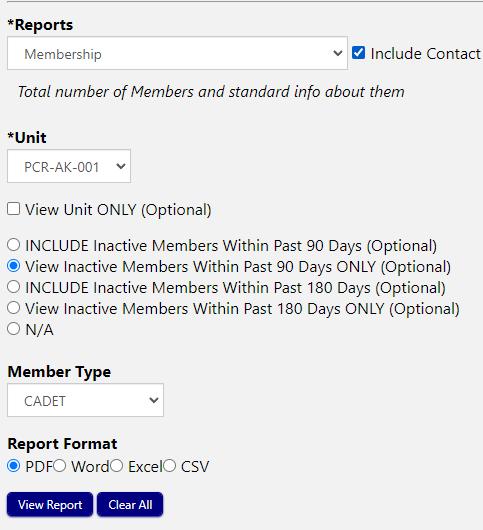
Consider contact those whose memberships have expired. For a few months, they may still have access to eServices and can renew online. Otherwise, they can call CAP Member Services on weekdays until noon Alaska Time at 1-800-227-9142 and select “4” for Personnel/Membership.

Senior Members and Cadets of the Alaska Wing,
CAP’s premier leadership & Search and Rescue program is taking applications for their 6-14 July 2024 summer school. Participants may apply for beginning or advanced Ground Team, Communications, Medic, Staff or Aircrew Survival tracks. Applications in eServices Registration Zone will close 15 June 2024. Details below.
This will be my fourth year on the mountain, and I cannot emphasise how valuable, and how fun this program is. For those who want to get a leg up, I am happy to meet with interested senior members and cadets virtually, or in person (after encampment), to accomplish pre-Hawk skills training.
V/r,
C/Lt Col Michael Porter, CAP
Assistant Communications & Emergency Services Officer Alaska Wing (C) 703.832.5961
For additional information, see the Hawk Mountain website (https://www.capranger.org/) and the Registration Zone link (https://www.capnhq.gov/CAP.Experiences.Web/Registration and search “hawk”).
AKWG will be conducting wing-wide Aircrew, Ground Team and ICS ES and Communications training beginning 1900 Friday, 17 May ending 1300 Sunday, 19 May 24.
Those interested in participating in-person or virtually as aircrew, ground team and mission base personnel, in any location, should forward their interests (what they are working on) and availability (Friday, Saturday, Saturday AM-only, etc) via email to the undersigned, Mission Staff Assistant C/Lt Col Michael Porter, 636865@akwg.cap.gov
Here is a list of areas/functions we plan on offering:
- Aircrew (MP, MO, MS)
- Planning and Operations Section Chief
- Air Operations Branch Director
- Ground Team Member (bring your Arctic-capable 24 and 72 hour packs, see attached packing lists for details)
- Mission Radio Operator
In addition to required Aircrew and Ground Team equipment (24/72 Hour Pack), in-person participants should prepare for cold/wet weather. This is the opportunity to see if your gear and you are really ready to survive and operate in the Alaskan wilderness for extended periods!
https://www.gotomeet.me/AlaskaWingCap
United States: +1 (646) 749-3122 - One-touch: tel:+16467493122,,824355869#
C/Lt Col Michael J. Porter, CAP Assistant Emergency Services & Communications Officer Alaska Wing (C) 703.832.5961
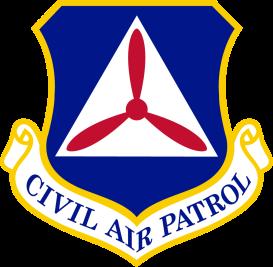


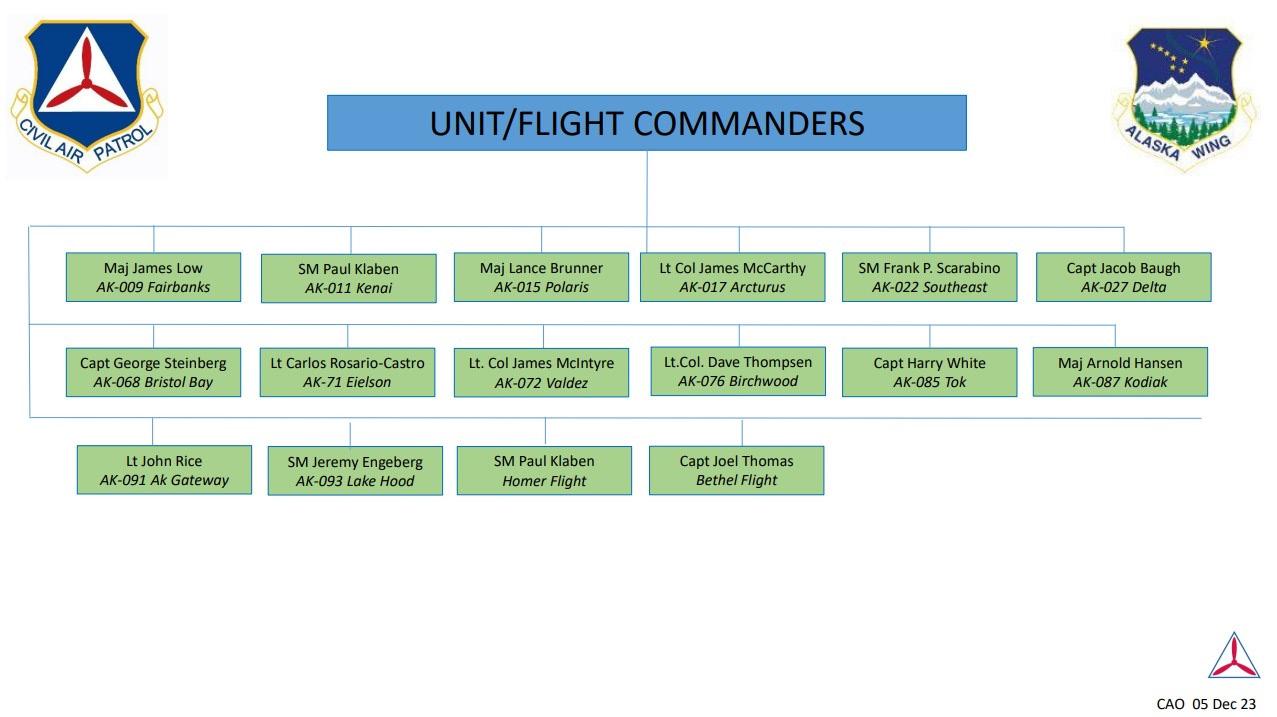
Alaska Wing Staff emails
Capt Brandon Anderson
brandon.anderson@akwg.cap.gov ig@akwg.cap.gov
Capt Donald (DJ) Burand dj.burand@akwg.cap.gov se@akwg.cap.gov
Lt Col Stuart Goering
stuart.goering@akwg.cap.gov ja@akwg.cap.gov
Capt Samantha (Reux) Stearns reux.stearns@akwg.cap.gov gr@akwg.cap.gov
2d Lt Elizabeth Justus
Lt Col Stephen Sammons
Lt Col Brian Porter
Lt Col Bryan Emerson
1st Lt Lynda MacPherson
Capt Karen Padgett
2d Lt Elizath Justus
SM Michael Inman
Maj Caleb Newville
elizabeth.justus@akwg.cap.gov
stephen.sammons@akwg.cap.gov cs@akwg.cap.gov
brian.porter@akwg.cap.gov do@akwg.cap.gov
bryan.emerson@akwg.cap.gov dc@akwg.cap.gov
lynda.macpherson@akwg.cap.gov ae@akwg.cap.gov
karen.padgett@akwg.cap.gov cp@akwg.cap.gov
elizabeth.justus@akwg.cap.gov recruiting@akwg.cap.gov
michael.inman@akwg.cap.gov lgm@akwg.cap.gov
caleb.newville@akwg.cap.gov it@akwg.cap.gov
Capt Terrance (Terry) Aldridge terry.aldridge@akwg.cap.gov fm@akwg.cap.gov
Maj Kevin Bottjen
1st Lt Mary Stella
Lt Col Bryan Emerson
kevin.bottjen@akwg.cap.gov hc@akwg.cap.gov
mary.stella@akwg.cap.gov da@akwg.cap.gov
bryan.emerson@akwg.cap.gov pa@akwg.cap.gov
Feel free to write your fellow members with questions and comments.
https://akwg.cap.gov/about/wing-vacancies
Assistant Public Affairs Officer - Public Relations, Digital
Engagement and Creative Services
Wing Command NCO
Wing NCO Advisor
Director of Personnel
Director of Development
Logistics Officer
Wing Historian
Health Services Officer
Inspector General
Plans and Programs Officer
Encampment Commander (2024 AKWG Encampment is scheduled for 13-22 June 2024)
Glider Flight Academy Activity Director (2024 AKWG Glider Academy is tentatively scheduled for 24 May-2 June 2024)
Powered Flight Academy (Distributed) Activity Director (need not be a pilot!) (2024 AKWG/National Powered Flight Academy takes place in instructors' and/or cadet students' home towns on their own schedule roughly 1 Mar -31 May 2024)
FOR FULL JOB DESCRIPTION AND DUTIES, REFER TO CAPP 30-1
The Alaska Wing of CAP performs more search and rescue operations than any other state. The target may be a downed airplane, a hiker, a kayaker, or, As Lt Col Coffing describes in his article above (p. 2), overdue snowmachiners. Recognizing ground to air emergency signals can bring fast relief to the stranded person on the ground.
If you ARE the stranded person, make sure that your signals are large enough, with strong color contrast, to be seen from several hundred feet in the air. Example: 10 + feet long saplings or dark logs on snow. Since horizontal straight lines are unusual in nature, these will catch a searcher’s eye. Alternatively, a triangle of three fires is a well recognized emergency signal.
Which symbols represent the following messages? (Find answers and other signals on p. 39):
* Require doctor, serious injury
* Require medical supplies
* Require mechanic
* All well
* Am proceding in this direction
* Aircraft badly damaged
* Probably safe to land here




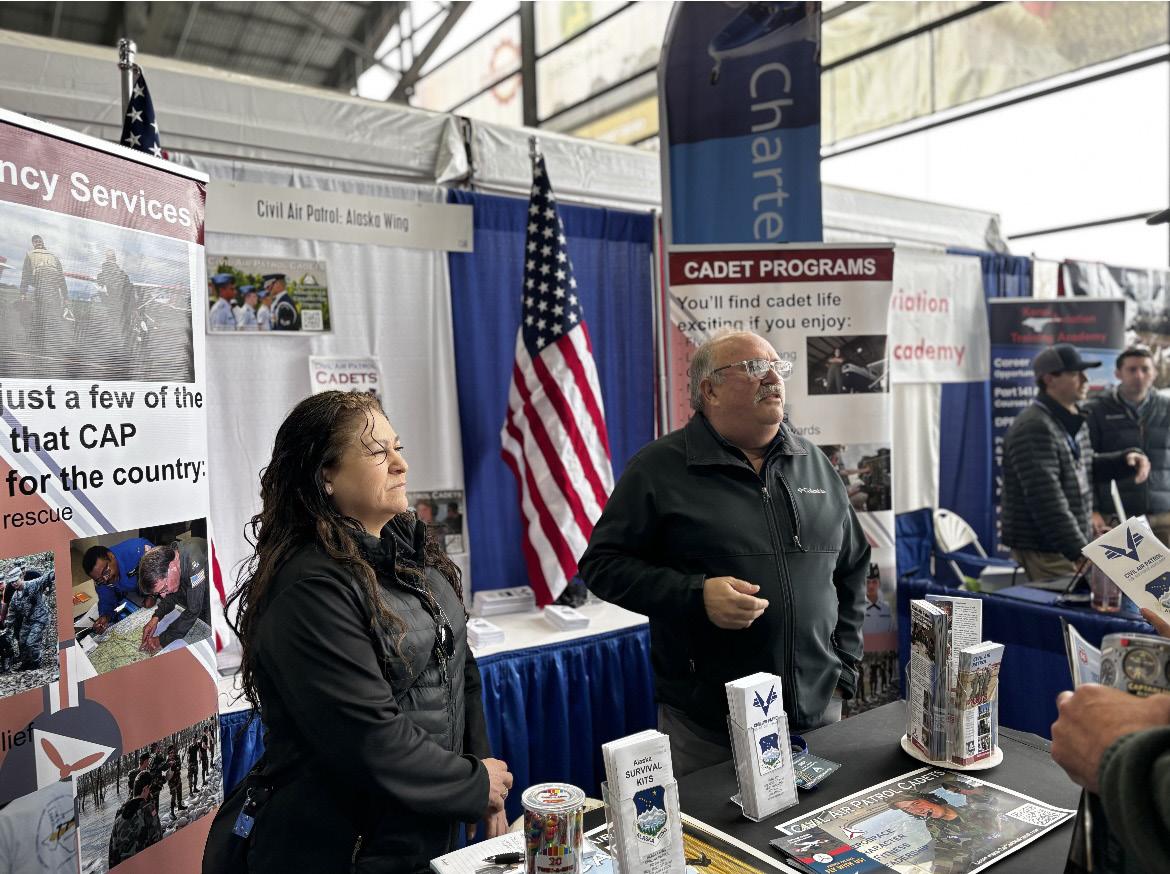
Please join Lt Elizabeth Justus, Lt. Col. Dave Thompsen (both pictured above by Capt Richard Dennis) and others at the CAP exhibit on Saturday, May 18th, at the Willow Community Center (right image).
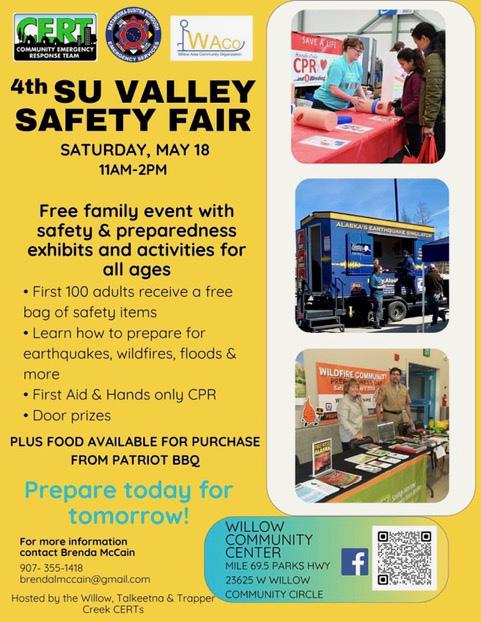
Please help us congratulate Col. Scott Maguire who was promoted to Oregon Wing Commander from Pacific Region Director of Public Affairs. Maj. Maryann Tooker, NVWG, assumed his former duty position.
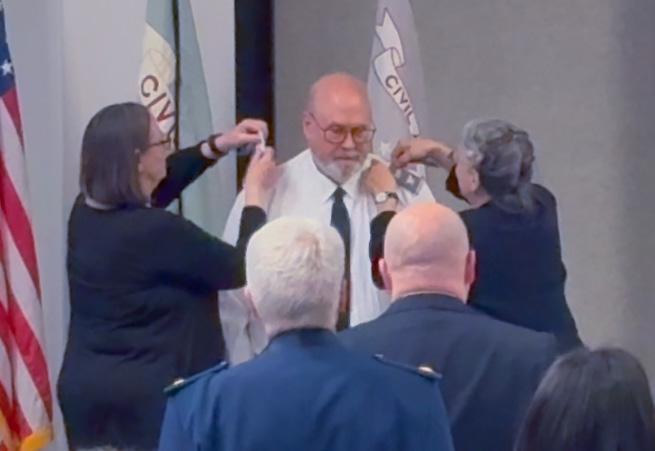


It is amazing to consider with how many other organizations Alaska CAP and its members (individually) collaborate professionally including, just to name a few, 11th Air Force, Air National Guard, Alaska State Troopers, US Coast Guard, NOAA/APRFC and FEMA. We have broad and deep experience that sets us apart from many other volunteer organizations and makes us the go-to resource for our three major Congressionally-mandated missionsEmergency Services, Cadet Programs and Aerospace Education.
This online publication is designed to attract, inform and motivate readers through photographs, text and stories. We see and feel the four core values in the faces and body language of the cadets and senior members portrayed herein. Submissions are accepted through the 10th of each month. Be safe and live our core values!
Volunteers serving America’s communities, saving lives, and shaping futures.

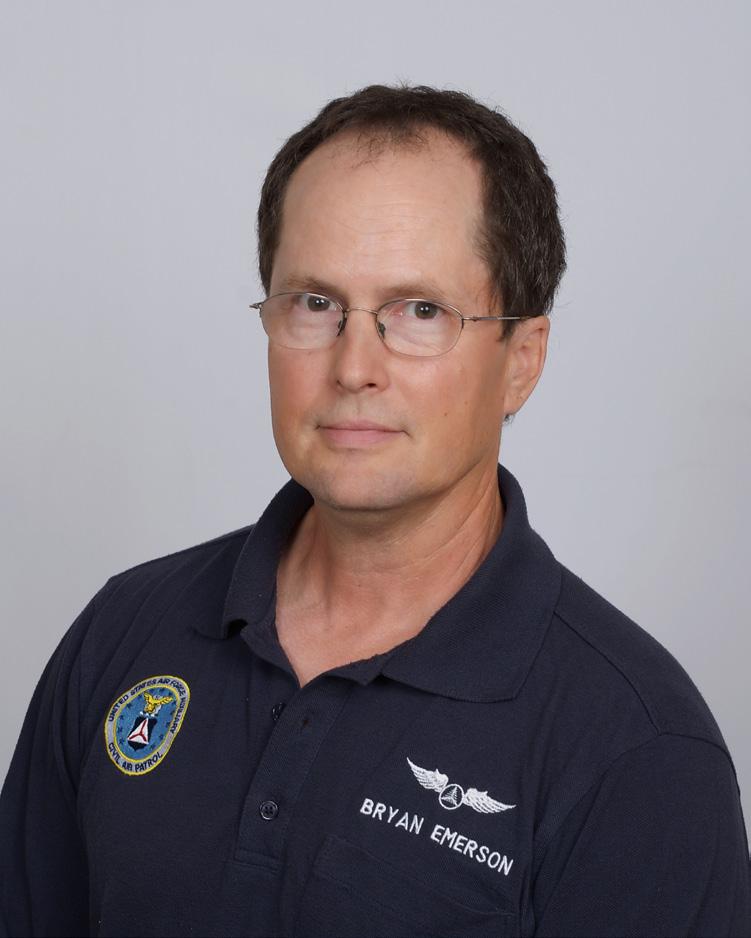
Lt Col Bryan Emerson, CAP Publisher and Editor
Alaska Wing PAO, DC BRYAN.EMERSON@ AKWG.CAP.GOV
1 (907) 795-5586 cel

Capt. Julie G. Rivera, CAP Co-Editor
Alaska Wing PAO Assistant 617596@AKWG.CAP.GOV 1 (787) 424-0560
